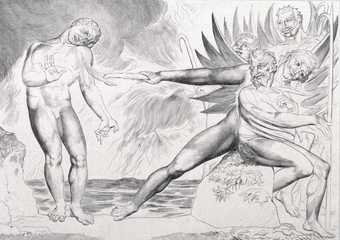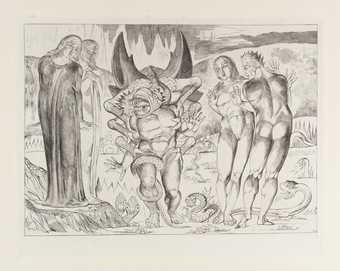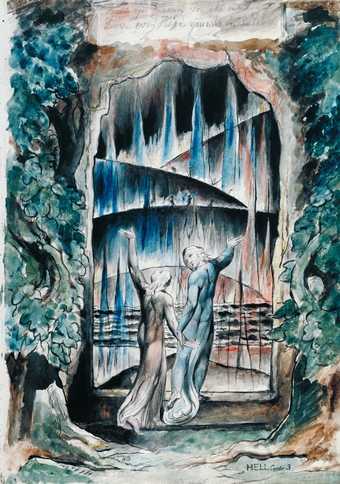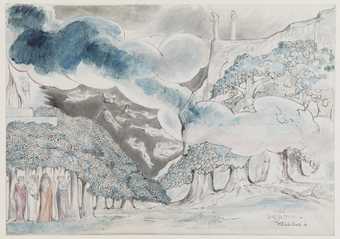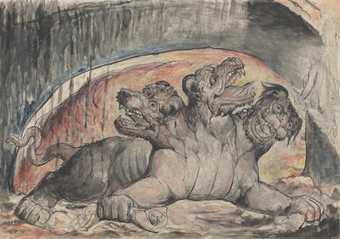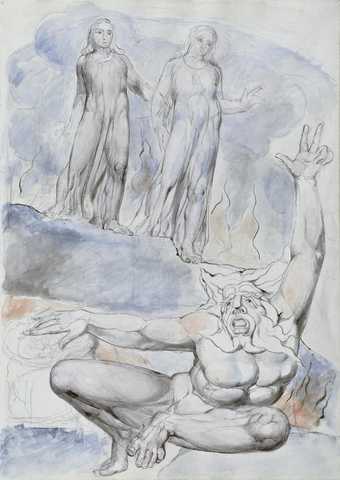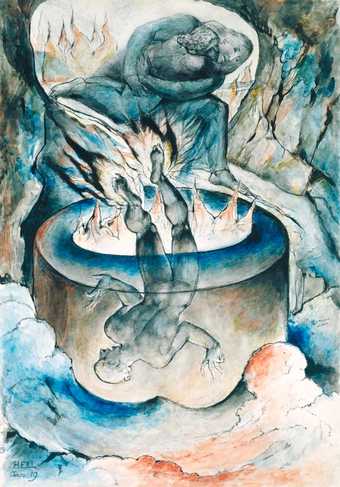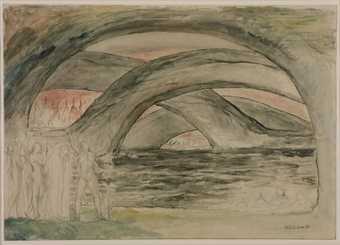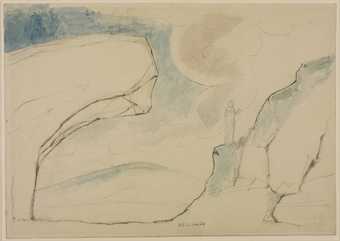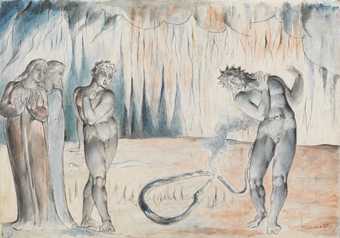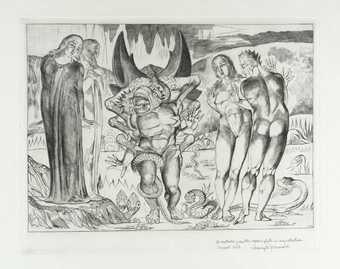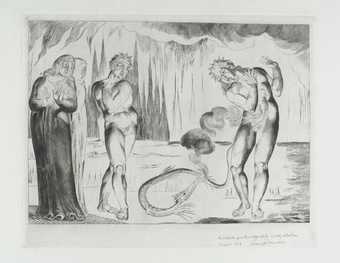
Not on display
- Artist
- William Blake 1757–1827
- Medium
- Chalk, ink and watercolour on paper
- Dimensions
- Support: 372 × 527 mm
frame: 602 × 745 × 22 mm - Collection
- Tate
- Acquisition
- Purchased with the assistance of a special grant from the National Gallery and donations from the Art Fund, Lord Duveen and others, and presented through the Art Fund 1919
- Reference
- N03364
Display caption
The heavy musculature of these female figures creates a gender ambiguity that may have implied moral degeneracy to a 19th-century audience. The contorted central body offers a parody of the graceful contraposto of classical statues, while the other cropped or truncated figures lounge about licentiously. Dante describes the thieves being bitten by snakes, creatures that Lavater associates with ‘cunning and treachery’. Here, however, the snakes appear to emanate from the women’s genitals, suggesting that their criminal activity has given birth to an aberration.
Gallery label, March 2011
Does this text contain inaccurate information or language that you feel we should improve or change? We would like to hear from you.
Catalogue entry
N03364 The Punishment of the Thieves 1824–7
N 03364 / B 812 102
Black chalk, pen and watercolour 372×527 (14 5/8×20 3/4)
Inscribed ‘Hell’ in pencil t.r. running vertically and, on reverse in pencil, ‘N20 next at p79’ t.c. and ‘80’ t.l., turned through a right-angle
Watermarked ‘WE’
Purchased with the assistance of a special grant from the National Gallery and donations from the National Art-Collections Fund, Lord Duveen and others, and presented through the National Art-Collections Fund 1919
PROVENANCE As for N03351
EXHIBITED Tate Gallery (42), Manchester (47), Nottingham (41) and Edinburgh (70) 1913–14, all as ‘Unidentified Subject of Dantesque Character’; English Painting Paris 1938 (165); Paris (repr.), Antwerp, Zurich (repr.) and Tate Gallery 1947 (29 vi)
LITERATURE ? Rossetti 1863, p.216 under no.101, and 1880, p.227 under no.123; Collins Baker in Huntington Library Quarterly, IV, 1940–1, p.365, repr.p.361 (reprinted in Essick 1973, pp.121–2, pl.44); Roe 1953, pp.101–4, 200–1 no.102, repr.; Klonsky 1977, p.119, repr.; Klonsky 1980, pp.148–9, pl.50; Butlin 1981, p.589 no.812 102; Gizzi 1983, p.128 repr.; Fuller in Art History 1988, pp.369–70
This watercolour is almost certainly a general view of the pit of thieves, the seventh pit of the eighth circle, as described in Inferno XXIV, 77–95, though no specific incident is depicted; another watercolour from the series, in the National Gallery of Victoria (Butlin 1981, no.812 47
recto, repr. Roe 1953, pl.47, Klonsky 1980, pl.49 and Gizzi 1983, p.127) gives a similarly generalized impression. There are seven further drawings from the two Cantos dealing with the thieves, who seem to have had a particular interest for Blake.
Roe, on the erroneous assumption that all the figures shown are female, suggests that the drawing is an allegory of Woman after the Fall with only a general reference to the Inferno: Woman, having accepted the help of the Serpent of Materialism to dominate Man, has here become its victim. Fuller sees a sexual suggestion in the serpents in Blake's designs showing the punishment of the thieves (see also N03361), and sees the rape by serpents as a negation of the victims' identities, which is of course the theme of these designs in which human beings turn into serpents and vice versa.
The figures in this watercolour are particularly Michelangelo-esque in the style and Collins Baker suggests that the figure of the standing woman leaning over in the centre is derived from an engraving after Michelangelo's ‘Last Judgement’ (a detail repr.1940–1, p.361; 1973, pl.45).
Published in:
Martin Butlin, William Blake 1757-1827, Tate Gallery Collections, V, London 1990
Explore
- literature and fiction(3,138)
- actions: postures and motions(9,111)
-
- contorted(76)
- pain(95)
- group(4,227)
- mythical, religious, fictional(260)
-
- Hell(93)
- Judaeo-Christian imagery(856)
-
- Hell(252)
- birth to death(1,472)
-
- death(685)
- punishment(22)
- crime and punishment(431)
-
- thief(17)
You might like
-
William Blake Ciampolo the Barrator Tormented by the Devils
1826–7, reprinted 1892 -
William Blake The Six-Footed Serpent Attacking Agnolo Brunelleschi
1826–7, reprinted 1892 -
William Blake The Serpent Attacking Buoso Donati
1826–7, reprinted 1892 -
William Blake The Inscription over the Gate
1824–7 -
William Blake Homer and the Ancient Poets
1824–7 -
William Blake Cerberus
1824–7 -
William Blake Plutus
1824–7 -
William Blake The Simoniac Pope
1824–7 -
William Blake The Devils, with Dante and Virgil by the Side of the Pool
1824–7 -
William Blake The Hypocrites with Caiaphas. Verso: Sketch of a Stooping Figure
1824–7 -
William Blake The Laborious Passage along the Rocks
1824–7 -
William Blake The Pit of Disease: The Falsifiers
1824–7 -
William Blake The Six-Footed Serpent Attacking Agnolo Brunelleschi
1826–7, reprinted 1968 -
William Blake The Serpent Attacking Buoso Donati
1826–7, reprinted 1968

